Copyright
1996-2024
by TSW
(Nikolay Tuzhilin)
Last updated: 02.01.2024
Overview
Lens motor is fast.
Infolitium battery is weird as it shows to you by smoothly decreasing percents that every second while you keep camera powered the energy left in the battery is quickly dissapears.
Sony SLT-α55V
5D vs. 1L (TODO!)
- Antishake
- 9 focus points
- Already have flash
- +|- accum
- - usb1.1
- better control
- smaller RAW files
- advance?
- better grip?
Comparing ... (TODO!)
??? megapixel is not noticeable difference in almost any circumstances, but comparing to Z2 it slightly compensate shorter optical zoom. Greater CCD leads to increased sensitivity with less noise amount and allows more narrow depth of field.
the same lens ???.
??? Larger sensor (60%) allows shorter DOF (deep of field) values. So with A1 you can try to make portraits (but maximal focal length is recommended to better diffuse background). And in the same time it is now harder to take macro shots, "big" objects tend to be out of focus with small aperture values and comparing to Z2 you should place it more far from the first lens (that it is more convenient, especially when you shot small animals, they do not like to be on 1cm distance from your camera).
USB interface and internal CompactFlash controller performance is not great (Direct speed is the transfer rate measured while copying 7.5M file thru USB camera connection, firmware v.1.02u):
| Flash model | Read time | Write time | Direct write speed | Direct read speed |
| Kingston 512MB | 14 sec | 23 sec | 320 KB/sec | 512 KB/sec |
| Kingston 1GB Elite Pro 50x | 14 sec | 23 sec | 320 KB/sec | 512 KB/sec |
| Transcend 2GB 120x | 8 sec | 16 sec | 450 KB/sec | 900 KB/sec |
For slow cards (Kingston Elite Pro 1GB, Kingston 512MB) continuous advance
for 5 taken RAW shots returns control to the camera in 9 seconds after shutter
release and completely flushes buffer in 50 seconds. So, internal write transfer
rate is about 880 KB/sec. Those flash cards have 6MB/sec transfer rate thru
USB2.0 card reader.
For modern fast cards like Transcend 120x 2GB continuous advance for 5 taken RAW
shots returns control to the camera after 2 seconds and allows you to take
following shots every 2 seconds. Buffer completely flushes in 9 seconds and
internal write transfer rate is about 4800 KB/sec. Those flash cards have
6MB/sec transfer rate thru USB2.0 card reader.
??? Autofocus fast and accurate but only when object is good illuminated, in dark room (and 99% of living rooms are dark) it takes some seconds and in the end you got red dot meaning "can't do it". What is interesting when you focus by the single center dot in the difficult conditions, camera can say that it focused successfully and later you will find that it has focused on the dot in the corner of the shot!
??? Due to the big (not as big as professional but bigger then usual) lens it is very difficult to take clear shots through the grid (e.g. small cage). There favorites is something like DiMAGE Xt with its very small nonextending lens.
Differences 5D vs. 7D vs. DL2(1L) vs. DS2(1S) (TODO!)
| Dynax 5D | Dynax 7D | Pentax DL2 (Samsung 1L) | Pentax DS2 (Samsung 1S) | |
| Body material | Plastic | Metal? | Plastic coating, metal subframe | |
| Focusing | TTL phase-detection system CCD line sensors (9 points, 8 lines with
center cross-hair sensor) -1 EV ~ 18 EV (at ISO 100 equivalent) |
TTL phase-detection system CCD line sensors (9 points, 8 lines with
center cross-hair sensor) -1 EV ~ 18 EV (at ISO 100 equivalent) |
TTL Phase-matching 5-point wide AF system (SAFOX VIII) EV 1 to 19 (ISO 200 with 50mm F1.4 lens) detection range |
11-area TTL Phase matching AF system (SAFOX VIII) Focus point selectable EV 0 to 19 (ISO 100) detection range |
| Metering | TTL metering; multi-segment metering, Center-weighted metering, Spot
metering. 14-segment honeycomb-pattern SPC. +1 EV ~ +20 EV (+4 EV to +20 EV with Spot metering), (at ISO 100 with f/1.4 lens) |
TTL metering; multi-segment metering, Center-weighted metering, Spot
metering. 14-segment honeycomb-pattern SPC. +1 EV ~ +20 EV (+4 EV to +20 EV with Spot metering), (at ISO 100 with f/1.4 lens) |
16-segment Center-Weighted Average, Spot EV 1 to 21.5 (at ISO 200 with 50 mm / F1.4 lens) |
16-segment Center-Weighted Average, Spot EV 1 to 21.5 (at ISO 200 with 50 mm / F1.4 lens) |
| Flash | GN 12 (at ISO 100) Manual lift-up 1/160 s (with Anti-Shake off), 1/125 s (with Anti-Shake on). External flash: Wireless/Remote flash, High-speed sync, Slow sync |
GN 12 (at ISO 100) Manual lift-up 1/160 s (with Anti-Shake off), 1/125 s (with Anti-Shake on). External flash: Wireless/Remote flash, High-speed sync, Slow sync |
Guide number 15.6 (ISO 200) Angle of coverage 28 mm Flash sync 1/180 sec Electronic pop-up 1/180 s External flash: Wireless sync, P-TTL sync |
Guide number 15.6 (ISO 200) Angle of coverage 28 mm Flash sync 1/180 sec Electronic pop-up 1/180 s External flash: Wireless sync, P-TTL sync |
| Flash metering system | ADI, Pre-flash TTL metering | ADI, Pre-flash TTL metering, manual | ??? | ??? |
| Flash compensation | ±2 EV in 1/3 EV increments | ± 2EV in 1/2 EV increments | ??? | ??? |
| DOF preview | Optical | Optical | Digital and optical | Optical |
| LCD Monitor | 2.5" TFT color, Total pixels: 115,000 | 2.5" TFT color, Total pixels: 207,000 | 2.5" TFT LCD , 210,000 pixels | 2.5" TFT LCD , 210,000 pixels |
| Viewfinder | Fixed eye-level system with roof mirror type pentaprism. Spherical Acute Matte focusing screen. Field of view 95% Magnification 0.83x with 50mm lens at infinity. Eye relief approx. 20 mm from the eyepiece, 16 mm from the eyepiece frame at -1 diopter. Diopter control -2.5 ~ +1.0 |
Eye-level fixed system with optical-glass pentaprism. Spherical Acute Matte (G-type as standard) focusing screen. Field of view 95% Magnification 0.9x with 50mm lens focused on infinity. Eye relief Approx. 25 mm from the eyepiece, 21 mm from the eyepiece frame in -1 diopter. Diopter control -3.0 ~ +1.0 |
Eye-level type fixed penta-mirror finder Natural bright-matte II focusing screen Magnification approx. x0.85 96% frame coverage Dioptric adjustment (-2.5 to +1.5) |
Pentaprism with Natural-Bright-Matte focusing screen Viewfinder Coverage - 95% Viewfinder Magnification - 0.95x (with 50mm f1.4 lens) Diopter Adjustment -2.5 to +1.5 |
| Continuous advance | Max. 5 frames (RAW), 3 frames (RAW+JPEG/L-EXTRA-FINE/L-FINE), max. 10 frames (L-FINE) | Max. 9 frames (RAW/RAW+JPEG), max. 12 frames (JPEG/L-EXTRA-FINE), max. 15 frames (JPEG/L-FINE) | 2.8 fps, up to 5 JPEG images, 3 RAW images | 2.8 fps up to 8 images |
| Interval | - | 2-240 frames, Interval time:0.5/1-10/15/20/30/45/60 minutes, Start timer is equipped. (Settings: 0.5 to 24 H, in 0.5 increments) | - | ??? |
| Digital Subject Programs | Portrait, Sports Action, Landscape, Sunset, and Night Portrait | - | Portrait, Landscape, Macro, Action, Night scene portrait, Night Scene, Surf &, Snow, Text, Sunset, Kids, Pet, Candlelight, Museum | Portrait, Night-scene Portrait, Landscape, Macro, Action |
| Exposure bracketing | With 0.3 EV / 0.7 EV increments, 3 frames | With 0.3 / 0.5 EV increments, 3 / 5 frames | 3 frames, 0.3, 0.5 or 1.0 EV steps | 3 frames, 0.3, 0.5 or 1.0 EV steps |
| Exposure compensation | ±2 EV in 1/3 EV increments | ±2 EV in 1/3 EV increments | -/+2.0 EV in 0.5 EV or 0.3 EV steps | -3 EV to +3 EV in 0.5 or 0.3 EV steps |
| Sensitivity | Auto, ISO 100 / 200 / 400 / 800 / 1600 / 3200 equivalent | Auto, ISO 100 / 200 / 400 / 800 / 1600 / 3200 equivalent | Auto, ISO 200 / 400 / 800 / 1600 / 3200 equivalent | Auto, ISO 200 / 400 / 800 / 1600 / 3200 equivalent |
| Computer interface | USB 2.0 Full-Speed 12Mbps data transfer | USB 2.0 High-Speed | USB 2.0 Hi-Speed | USB 2.0 Hi-Speed |
| EXIF version | 2.21 | 2.2 | 2.21 | |
| Startup time | Approx. 1 s | Approx. 2 s | ||
| Zoom when viewing | RAW (any), JPEG | RAW+JPEG (only), JPEG | ||
| Automatic image rotating | When recording and viewing | - | ||
| Control from PC | No | ? | ||
| Storage | CompactFlash | CompactFlash | SD card | SD/MMC card |
| Batteries | One NP-400 lithium-ion battery | One NP-400 lithium-ion battery. Vertical Control Grip VC-7D (possible to adopt two NP-400 batteries, or six AA size Ni-MH batteries) |
4 x AA batteries (NiMH rechargeable recommended) or 2 x CR-V3 |
AA (4) batteries (NiMH recommended) or 2 x CR-V3 |
| Battery performance | 550 | 400 | 750 (2xCR-V3) | |
| Dimensions | 130.5 x 92.5 x 66.5 mm | 150 x 106 x 77.5 mm | 125 x 93 x 67 mm | 125 x 93 x 66 mm |
| Weight (including battery) | 590 g | 760 g | 470 g | 470 g |
Reviews
Dynax 5D review by
Steves Digicams.
Flash cards speed test results at
Dyxum.
The following information and specifications are copied from the official Konica Minolta web site:
Anti-Shake Technology
The solution of an age-old problem
No matter how advanced the camera, or how skilled the photographer, an
otherwise-perfect photograph can be ruined by camera shake. Because camera shake
is a fact of life — particularly at slow shutter speeds, or when shooting with
high-power telephoto, zoom or macro lenses. Sometimes you can get around the
problem by using a tripod. But not always. Even if you've got one handy, the
situation may demand the mobility and freedom of handheld shooting. And it may
require the use of slower shutter speeds, simply because you can't use a flash.
Whatever the reason, now at last there is a solution: Konica Minolta Anti-Shake.
Keeping you informed.
A convenient 5-step indicator in the viewfinder keeps you informed of Anti-Shake
system activity. Displayed at the right side of the viewfinder, it allows you to
confirm the amount of camera shake at a glance.
The revolutionary Konica Minolta body-integral CCD-Shift mechanism
What sets the DYNAX 5D's Anti-Shake apart from all other camera-shake compensation systems is its exclusive CCD-Shift mechanism. Consisting of an extremely sensitive angle-speed sensor and a robust new Smooth Impact Drive Mechanism (SIDM) specifically designed to match the DYNAX 5D's large CCD, the system instantly and precisely shifts the CCD to compensate for camera motion. It's so effective you can shoot at shutter speeds two or three steps slower than what you could use without it. So even in low light, you can keep your images clean and sharp, free of the noise that creeps in when you boost ISO sensitivity. And because the mechanism is integrated directly into the camera's body, it works with virtually any DYNAX AF lens — another major advantage.
Effective at any focal length
Only Konica Minolta offers effective Anti-Shake protection across the entire
spectrum of lens performance. Whatever type of lens you're using — telephoto,
wide-angle, zoom, macro or standard — the DYNAX 7D analyzes data on focal
length, current aperture setting, and focusing distance so that it can optimize
Anti-Shake performance to offer the highest level of protection. Anti-Shake
effect decreases when the lens with Macro switch function is set for Macro
shooting.
Anti-Shake effect decreases when the lens with focus limiter function is used in
the focal length other than infinity with limiter setting. (except SSM lenses
and Macro (D) lenses).
Protection for every occasion
Anti-Shake can make the difference between a good photo and a great photo in a wide range of situations. For long telephoto shots and close-up macro photos, of course, it's practically essential. But it can also give you much greater freedom when you want to shoot romantic candlelit portraits, twilight cityscapes, or artwork in museums where you can't use a flash. Unlike systems that only compensate for high-speed shake, Konica Minolta Anti-Shake is equally effective against low-speed shake.
High image quality
The fine resolution and rich detail of 6.1-megapixel imaging
Exceptional color and image detail are assured by a high-resolution, 6.1-megapixel CCD (effective pixels). Not only does the CCD allow you to capture fine details and rich, natural colour, it has a wide dynamic range that helps to enhance image quality in areas of highlight and shadow.
The enhanced quality and speed of Konica Minolta image processing
The DYNAX 5D's advanced image processor uses proprietary Konica Minolta technology to significantly reduce signal noise and assure dramatically improved image quality. In addition, high-speed data handling allows quick, responsive shooting.
The rich, natural colors and textures of CxProcessTM III image optimization
Exclusive CxProcess III technology optimizes color saturation, edge sharpness, and image contrast to ensure that colors are rendered just as the human eye perceives them. In addition, it helps suppress signal noise and assures rich textural detail and natural skin tones.
The quality and precision of the complete DYNAX lens lineup
With the DYNAX 5D, you can take advantage of the full lineup of genuine, high-precision Konica Minolta lenses, and enjoy the benefits of Anti-Shake protection at any focal length. Many of the lenses incorporate the latest advances in optical technology, and feature high-quality aspherical elements and AD (Anomalous Dispersion) glass for superior sharpness, contrast, and color fidelity.
3 color space mode selection
3 color space mode selection offers a choice of Natural (sRGB) and Natural+ (sRGB), and AdobeRGB mode. The default Natural setting provides clear color and delicate textures, while Natural+ enhances both contrast and shadow. AdobeRGB offers a wider color gamut than sRGB.
Simultaneous RAW & JPEG Capture
The post-processing flexibility of simultaneous RAW/JPEG recording.
Simultaneous RAW and JPEG data recording gives you much greater freedom in how
you process your images. By saving the image in both formats, you can quickly
display the JPEG version as a reference when you edit and process the RAW data
for final output as a beautiful gallery-quality print suitable for framing and
permanent display.
Large CCD & easy control
Large, 2.5-inch LCD for easy shooting, reviewing, and settings selection
A large, 2.5-inch LCD monitor makes it easy to compose and review your shots. In recording mode, the screen displays detailed information about current settings and exposure values in large, easy-to-read type, and automatically switches to a vertical-format display when you rotate the camera for vertical shooting. Versatile display functions include a multi-frame File Browser that allows you to quickly scan through stored images, and a new interface layout that makes it easy to navigate the menus and select advanced settings. In addition, the monitor screen is protected by a hard, scratch-resistant coating, and turns off automatically to conserve battery power when you put your eye to viewfinder.
Compact design for superior handling and mobility
The DYNAX 5D packs powerful SLR performance into an extremely compact body for high mobility and quick, responsive handling. The ergonomically designed grip also enhances stability and security when shooting.
Digital Subject Program Selection-optimum settings, applied with ease
These ready-made solutions make it easy to obtain optimum results in a wide range of shooting situations. Instead of fumbling with various settings individually, you can simply set the mode dial on the top of the camera to the Digital Subject Program that matches the scene you're shooting. When you choose Night Portrait mode, for example, the camera automatically applies a combination of settings to ensure that people in the foreground and lights in the background are both correctly exposed.
Conveniently positioned dials and controls
An intuitive control layout adds to the DYNAX 5D's outstanding ease of use. Large, clearly labeled dials make it easy to select exposure and white balance modes. In addition, the exposure-compensation, AE lock, and function buttons are conveniently positioned for easy operation.
Bright, clear viewfinder for easy focusing and framing
The viewfinder offers a bright, clear view of your subject, and features a spherical acute matte focusing screen that makes it exceptionally easy to confirm focus.
Fast, one-push access to frequently used settings
A conveniently positioned Function button provides instant one-push access to key settings. Just press it, and the LCD monitor will immediately display an easy-to-understand menu from which you can select the autofocus area, autofocus mode, metering mode, flash-compensation value, color mode, and the degree of contrast, saturation, and sharpness.
Advanced functions
Smooth, responsive continuous shooting
The DYNAX 5D 5D lets you capture up to 10 frames at a speed of approximately 3 frames per second (in Large/Fine JPEG mode). It's a great way to capture the "magic moment" when taking photos of sports events, children, and fast-paced action, and the camera's high recording speed enables you to continue shooting smoothly afterwards.
The confident precision of 9-point autofocusing
A high-performance autofocusing system with nine separate AF sensors provides wide-area coverage for accurate focusing even when your subject is off-center in the frame. It also gives you great flexibility in how you compose your shots, and allows you to select any of the nine sensors as the primary AF area. In addition, Predictive Focus Control helps you maintain accurate focus when shooting moving subjects. AF may not work depending on the combination between lens and teleconverter. (e.g. AF does not work if open aperture is above f/8.)
The added security of automatic exposure bracketing
If tricky lighting conditions are a source of concern, you can put your mind at ease by using automatic exposure bracketing. The camera will automatically fire three shots when the shutter-release button is held down, bracketing the initial exposure with two more shots taken at higher and lower exposure settings.
Metering solutions to suit any scene
The DYNAX 5D offers you a choice of 14-segment honeycomb-pattern metering, center-weighted metering, and spot metering, so you can choose the metering mode that best suits the needs of each scene. The 14-segment honeycomb pattern metering is particularly versatile, and employs sophisticated metering algorithms to ensure beautiful results in high-contrast and backlit situations. Exposure compensation can also be set in 1/3-EV increments.
A full range of exposure-control modes for maximum creativity
From programmed automation to full manual control, the DYNAX 5D offers a full
range of exposure modes for creative SLR photography.
P (Programmed AE) mode allows you to concentrate on composition while the camera
selects the optimum aperture and shutter-speed settings for you.
A (Aperture Priority) mode allows you to precisely control the depth of field by
setting the aperture manually; shutter speed is set automatically.
S (Shutter Priority) mode allows you to freeze the action or control the blur
from subject motion by setting the shutter speed manually; aperture is set
automatically.
M (Manual) mode offers the ultimate in creative control; both aperture and
shutter speed settings can be set manually.
Versatile white-balance controls for natural color balance
A full complement of white-balance controls allows you to achieve natural color balance in a wide range of situations. In addition to auto white balance, six presets, and one custom setting, there are direct white-balance color-temperature settings for professional-level color control. You can also use auto white-balance bracketing to obtain a series of 3 images from which you can select the one that offers the precise balance you want.
Customizable settings for creative image control
In addition to Digital Subject Program Selection that automatically applies optimized exposure and image processing program settings to the scene you are shooting, the DYNAX 5D offers Digital Effects Control for creative imaging. Using Digital Effects Control, you can adjust contrast, saturation, and sharpness parameters for each of ten color modes to achieve your creative goals.
Zone Matching for beautiful results with high-contrast subjects
Achieving correct exposure can be tricky when you're shooting very light or very dark subjects against a similar-toned background. But with the DYNAX 5D / MAXXUM 5D, you've got a built-in solution to the problem. It's called Zone Matching, and it automatically compensates for the problem of blown-out highlights or lost shadow detail that can occur with high-key and low-key subjects.
Built-in flash for beautiful results in low light and backlight
A built-in flash provides supplementary illumination whenever you need it. Equipped with Auto and Red-Eye Reduction modes for shooting in low light, it also has a Fill Flash mode to help erase shadows and provide balanced illumination in backlight. In addition, there's a Rear Sync flash mode that lets you create interesting motion-blur effects when shooting at night.
Extend your creative horizons with powerful external flash units
An extensive lineup of Konica Minolta external flash units is also available for the DYNAX 5D. These high-power units offer greater range and coverage, and allow you to take advantage of advanced flash techniques to achieve more natural illumination. When teamed with DYNAX D series lenses, Konica Minolta external flash units also let you enjoy the benefits of Advanced Distance Integration (ADI) flash metering, which assures beautifully balanced exposures even when shooting subjects against very light, dark, or reflective backgrounds.
| Camera type | Digital SLR with built-in flash and interchangeable lenses | ||||||||||||||||||||||||||||||||||||||||||||||||
| Lens mount | Minolta A-type bayonet mount | ||||||||||||||||||||||||||||||||||||||||||||||||
| Image capture | Image sensor | Interline primary color CCD (23.5 mm x 15.7 mm) with interlace scan | |||||||||||||||||||||||||||||||||||||||||||||||
| Number of pixels | Approx. total: 6.3 million, effective: 6.1 million | ||||||||||||||||||||||||||||||||||||||||||||||||
| A/D conversion | ??? | ||||||||||||||||||||||||||||||||||||||||||||||||
| Sensitivity | Auto, ISO 100 / 200 / 400 / 800 / 1600 / 3200 equivalent | ||||||||||||||||||||||||||||||||||||||||||||||||
| Aspect ratio | 3:2 | ||||||||||||||||||||||||||||||||||||||||||||||||
| White-balance control | Automatic, Preset (Daylight, Shade, Cloudy, Tungsten, Fluorescent, Flash), Custom, Color temperature (2500 ~ 9900K with 19-step Magenta/Green compensation) | ||||||||||||||||||||||||||||||||||||||||||||||||
| Recording | Number of recorded pixels | L: 3008 x 2000, M: 2256 x 1496, S: 1504 x 1000 | |||||||||||||||||||||||||||||||||||||||||||||||
| Recording media | Type I and Type II CompactFlash Cards, Microdrive, SD/MMC memory card (with optional SD-CF1) | ||||||||||||||||||||||||||||||||||||||||||||||||
| File formats | JPEG, RAW (DCF 2.0 compliant, DPOF supported by printing functions in ver.1.1, Exif 2.21) |
||||||||||||||||||||||||||||||||||||||||||||||||
| Image-quality modes | Standard, Fine, Extra-Fine, RAW, RAW+JPEG | ||||||||||||||||||||||||||||||||||||||||||||||||
| Color modes | Natural, Natural Plus, Portrait, Landscape, Sunset, Night View, Night Portrait, Black & White, Adobe RGB, Embedded Adobe RGB. Except for Adobe RGB and Embedded Adobe RGB, all other color modes use the sRGB color space. | ||||||||||||||||||||||||||||||||||||||||||||||||
| Contrast / Saturation / Sharpness | 5 steps: +2, -1, ±0, +1, +2 | ||||||||||||||||||||||||||||||||||||||||||||||||
| Noise reduction | Available at shutter speeds longer than 1s | ||||||||||||||||||||||||||||||||||||||||||||||||
| Delete function | Single, multiple, or all frames in a folder / memory card can be deleted. Folders can be deleted in the File Browser. | ||||||||||||||||||||||||||||||||||||||||||||||||
| File size |
|
||||||||||||||||||||||||||||||||||||||||||||||||
| Storage capacity | Approximate storage capacity of a 512MB memory card:
|
||||||||||||||||||||||||||||||||||||||||||||||||
| Anti-shake | CCD-Shift mechanism. Approx. 2 EV ~ 3 EV decrease in shutter speed
(varies according to shooting conditions and lens used). Anti-Shake scale in viewfinder. |
||||||||||||||||||||||||||||||||||||||||||||||||
| Time lag for shutter release | Approx. 0.12 s (from when the shutter-release button is pressed down to when the exposure starts) | ||||||||||||||||||||||||||||||||||||||||||||||||
| Format function | FAT 12, 16, 32 supported | ||||||||||||||||||||||||||||||||||||||||||||||||
| Folder name formats | Standard, Date | ||||||||||||||||||||||||||||||||||||||||||||||||
| Exif tag information | Date and time, Camera settings (Exposure mode, Shutter speed, Aperture value, Exposure compensation value, Metering method, Flash on / off, Camera sensitivity, White balance setting, Focal length, etc.), Color space |
||||||||||||||||||||||||||||||||||||||||||||||||
| Viewfinder | Type | Fixed eye-level system with roof mirror type pentaprism | |||||||||||||||||||||||||||||||||||||||||||||||
| Focusing screen | Spherical Acute Matte | ||||||||||||||||||||||||||||||||||||||||||||||||
| Field of view | 95% | ||||||||||||||||||||||||||||||||||||||||||||||||
| Magnification | 0.83x with 50mm lens at infinity, -1 m-1 | ||||||||||||||||||||||||||||||||||||||||||||||||
| Eye relief | Approx. 20 mm from the eyepiece, 16 mm from the eyepiece frame at -1
diopter (-1m-1). Eyepiece cup removable. |
||||||||||||||||||||||||||||||||||||||||||||||||
| Diopter control | -2.5 ~ +1.0 m-1 | ||||||||||||||||||||||||||||||||||||||||||||||||
| Shutter | Type | Electronically-controlled, vertical-traverse, focal-plane type | |||||||||||||||||||||||||||||||||||||||||||||||
| Speed range | 1/4000 s ~ 30 s, bulb exposures possible (approx. 3.5 hours with fully recharged battery) | ||||||||||||||||||||||||||||||||||||||||||||||||
| Flash-sync speeds | 1/160 s (with Anti-Shake off), 1/125 s (with Anti-Shake on), High-speed sync available with Program Flash 5600HS(D) / 3600HS(D) | ||||||||||||||||||||||||||||||||||||||||||||||||
| Autofocus system | Type | TTL phase-detection system | |||||||||||||||||||||||||||||||||||||||||||||||
| Sensor | CCD line sensors (9 points, 8 lines with center cross-hair sensor) | ||||||||||||||||||||||||||||||||||||||||||||||||
| Sensitivity range | -1 EV ~ 18 EV (at ISO 100 equivalent) | ||||||||||||||||||||||||||||||||||||||||||||||||
| Autofocus areas | Wide AF area, spot AF area, and 9 local AF areas with Focus Area Selection | ||||||||||||||||||||||||||||||||||||||||||||||||
| Focus modes | AF-A / AF-S / AF-C / DMF. Predictive Focus Control (with moving subjects in AF-A and AF-C), auto-tracking focus-point display | ||||||||||||||||||||||||||||||||||||||||||||||||
| AF illuminator | Available with built-in flash. Range: 1 m ~ 5 m. When using an external flash which employs AF illuminator function, the AF illuminator of the external flash functions. |
||||||||||||||||||||||||||||||||||||||||||||||||
| AE system | Metering type | TTL metering; multi-segment metering, Center-weighted metering, Spot metering | |||||||||||||||||||||||||||||||||||||||||||||||
| Metering cell | 14-segment honeycomb-pattern SPC | ||||||||||||||||||||||||||||||||||||||||||||||||
| Metering range | +1 EV ~ +20 EV (+4 EV to +20 EV with Spot metering), (at ISO 100 with f/1.4 lens) | ||||||||||||||||||||||||||||||||||||||||||||||||
| Exposure modes | P (Programmed AE) (with program shift), A (Aperture priority), S (Shutter priority), M (Manual. | ||||||||||||||||||||||||||||||||||||||||||||||||
| Digital Subject Programs | Portrait, Sports Action, Landscape, Sunset, and Night Portrait | ||||||||||||||||||||||||||||||||||||||||||||||||
| AE lock | Automatically activated with AF lock, available via AEL button | ||||||||||||||||||||||||||||||||||||||||||||||||
| Exposure compensation | ±2 EV in 1/3 EV increments | ||||||||||||||||||||||||||||||||||||||||||||||||
| Built-in flash | Flash metering system | ADI, Pre-flash TTL metering | |||||||||||||||||||||||||||||||||||||||||||||||
| Guide No. | GN 12 (in meters at ISO 100) | ||||||||||||||||||||||||||||||||||||||||||||||||
| Recycling time | 3 seconds (approx.) | ||||||||||||||||||||||||||||||||||||||||||||||||
| Control | Manual (lift-up for Fill Flash, push down for Flash Cancel) | ||||||||||||||||||||||||||||||||||||||||||||||||
| Flash modes | Fill-flash, Red-eye reduction, Rear flash sync, Wireless / Remote flash, High-speed sync, Slow sync activated via AE lock button | ||||||||||||||||||||||||||||||||||||||||||||||||
| Flash range | ??? | ||||||||||||||||||||||||||||||||||||||||||||||||
| External flashes | Auto-flash metering with Program/Maxxum Flash 2500 (D), 3600HS (D), 5600HS (D), Macro Twin Flash 2400, Macro Ring Flash 1200 (Macro Flash Controller is necessary) | ||||||||||||||||||||||||||||||||||||||||||||||||
| Flash compensation | ±2 EV in 1/3 EV increments | ||||||||||||||||||||||||||||||||||||||||||||||||
| Drive | Modes | Single-frame advance, Continuous advance, Self-timer, Single-frame advance bracketing, Continuous-advance bracketing. Continuous-advance rate: 3 frames per second (approx.), Max. 5 frames (RAW), max. 3 frames (RAW+JPEG) | |||||||||||||||||||||||||||||||||||||||||||||||
| Frames recorded | Number of frames recorded based on image quality and size:
|
||||||||||||||||||||||||||||||||||||||||||||||||
| Self-timer | 10s / 2s delay selectable, with time display by LED | ||||||||||||||||||||||||||||||||||||||||||||||||
| Exposure bracketing | With 0.3 EV / 0.7 EV increments, 3 frames | ||||||||||||||||||||||||||||||||||||||||||||||||
| Playback | LCD Monitor | 2.5-in (63mm) TFT color, Total pixels: 115,000 | |||||||||||||||||||||||||||||||||||||||||||||||
| Playback mode | Single-frame (Image only, Image and information), Histogram with luminance limit display, Index (4, 9, or 16 frames), Enlarged playback (up to approx. 5x), File Browser, Slideshow, manual and auto rotation | ||||||||||||||||||||||||||||||||||||||||||||||||
| Printing output control | Exif Print, PRINT Image Matching II | ||||||||||||||||||||||||||||||||||||||||||||||||
| Others | Other functions | Instant playback, Customization, Zone Matching, Depth-of-field preview | |||||||||||||||||||||||||||||||||||||||||||||||
| Batteries | One NP-400 lithium-ion battery | ||||||||||||||||||||||||||||||||||||||||||||||||
| Battery performance | No. of frames recorded: approx. 550 (CIPA measurement), approx. 700 (Konica Minolta measurement) | ||||||||||||||||||||||||||||||||||||||||||||||||
| External power source | 6V DC (AC-1L or AC-11) | ||||||||||||||||||||||||||||||||||||||||||||||||
| Computer interface | USB 2.0 Full-Speed 12Mbps data transfer | ||||||||||||||||||||||||||||||||||||||||||||||||
| Video output | PAL / NTSC | ||||||||||||||||||||||||||||||||||||||||||||||||
| Operating temperature | 0 to 40 degrees centigrade | ||||||||||||||||||||||||||||||||||||||||||||||||
| Dimensions (WxHxD) | Approx. 130.5 mm x 92.5 mm x 66.5 mm | ||||||||||||||||||||||||||||||||||||||||||||||||
| Weight | Approx. 590g (without batteries, memory card and body accessories) | ||||||||||||||||||||||||||||||||||||||||||||||||
Name of parts
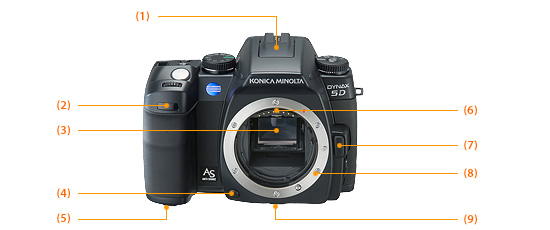 |
1. Built-in flash 2. Self-timer lamp 3. Mirror 4. Depth-of-field preview button 5. Battery-chamber door 6. Lens contacts 7. Lens release 8. Mounting index 9. Tripod socket |
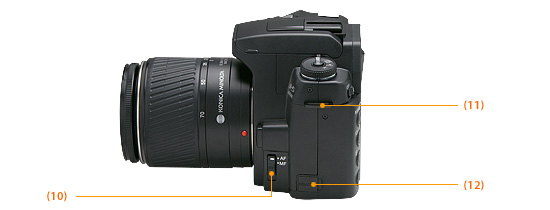 |
10. AF/MF switch 11. Strap eyelet 12. Remote-control terminal |
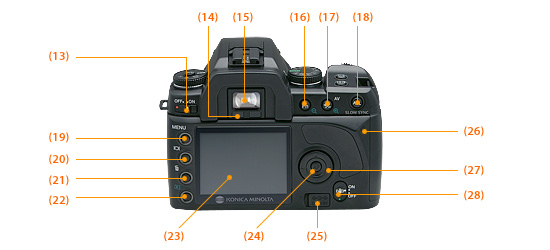 |
13. Main switch 14. Eyepiece sensors 15. Viewfinder 16. Function button 17. Exposure compensation button/ Magnification button 18. AE lock button 19. Menu button 20. Display button 21. Delete button 22. Playback button 23. LCD monitor 24. Spot-AF button 25. DC terminal 26. Access lamp 27. Controller 28. Anti-Shake switch |
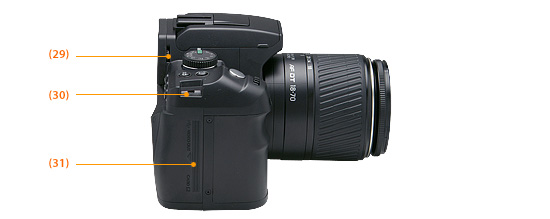 |
29. Diopter-adjustment dial 30. Strap eyelet 31. Card-slot / USB port / Video-out terminal door |
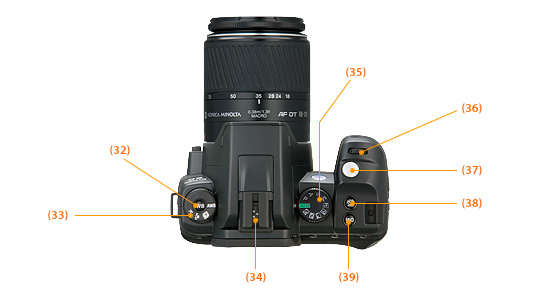 |
32. White-balance button 33. White-balance dial 34. Accessory shoe 35. Exposure mode dial 36. Control dial 37. Shutter-release button 38. Drive-mode button 39. Camera sensitivity (ISO) button |
